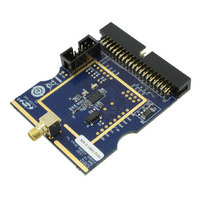1012-TAB1D434 Silicon Laboratories Inc, 1012-TAB1D434 Datasheet

1012-TAB1D434
Specifications of 1012-TAB1D434
Related parts for 1012-TAB1D434
1012-TAB1D434 Summary of contents
Page 1
Si1000/Si1010 W 1. Introduction This application note will help you get a quick start on demonstration, evaluation, or code development with the Si10xx products. 1.1. Choose between Evaluation, Demonstration, or Code Development Evaluate the radio performance or experiment with ...
Page 2
Si1000/10 QSG 1.2. WDS RF Test Equipment Using the WDS Chip Configurator software is the best way to evaluate the RF performance in the lab with various configurations. The WDS GUI provides a convenient way to run ...
Page 3
Connect the USB cable (which will supply power and USB communications). 5. Turn on power: SW5 Download the LoadBoard Light code to each. (See "3. Silicon Laboratories IDE Code Download" on page 16). File location: C:\SiLabs\MCU\Examples\Si100x\EZRadioPRO\WDS_Support\lb_light.hex ...
Page 4
Si1000/10 QSG d. Select GFSK from Modulation Type. e. Select PN9 from Modulation Data. f. Click Update to write these values to the radio. 11. Connect a spectrum analyzer to the antenna output: You should see a GFSK-modulated test signal ...
Page 5
Choose Register Setting Panel and Select. b. Scroll down to register 6D, the TX Power register. Set bits TXPOW[2: Click the W icon to write this register. Si1000/10 QSG Rev. 0.1 5 ...
Page 6
Si1000/10 QSG c. Verify that the transmitter power has increased by checking the spectrum analyzer: 6 Rev. 0.1 ...
Page 7
Code Development A number of RF programming examples are included with the standard Silicon Laboratories IDE installation. This section will get you started building and running one of those examples. 1. Install the Silicon Labs IDE software. Use the ...
Page 8
Si1000/10 QSG 11. Ensure the Si1000 EVB is selected as a target: 8 Rev. 0.1 ...
Page 9
MHz: Si1000/10 QSG Rev. 0.1 9 ...
Page 10
Si1000/10 QSG 13.Fine-tune the EVB's crystal frequency. Scroll down to the RadioInit function and add a phyWrite command: 10 Rev. 0.1 ...
Page 11
Press ctrl-shift-F7 to compile and build. b. Press the [DL] Icon to download. c. Ensure Download Successful appears in the Output Window. 15.Run: F5 Si1000/10 QSG Rev. 0.1 11 ...
Page 12
Si1000/10 QSG 16.Connect spectrum analyzer to antenna port and verify modulated spectrum. 12 Rev. 0.1 ...
Page 13
Portable Demo Quick Start Note: This demo available with Software Development Board firmware v3.74 and later. This demo will configure two Si10xx devices to ping-pong a message back and forth. One node will send a packet to the second. ...
Page 14
Si1000/10 QSG 6. On page 2/4, select 2.4 kbps, GFSK, 903.0 MHz, and GO page 3/4, select output power +8 dBm and GO page 4/4, change ID: Destination to match the other card's ID: Self: Choose ...
Page 15
For More Information Device data sheets Si1000 Si1010 Evaluation board information Si10xx-DK User's Guide SDBC-DK3 User Guide Revision 0.4 RF card schematics and PCB layout (www.silabs.com) Register information, programming guides, and examples AN440: ...
Page 16
Si1000/10 QSG 3. Silicon Laboratories IDE Code Download 1. Install the Silicon Labs IDE software. Use the included CD or download from www.silabs.com. 2. Connect the USB Programming Adapter to your computer. 3. Plug the radio card in to the ...















